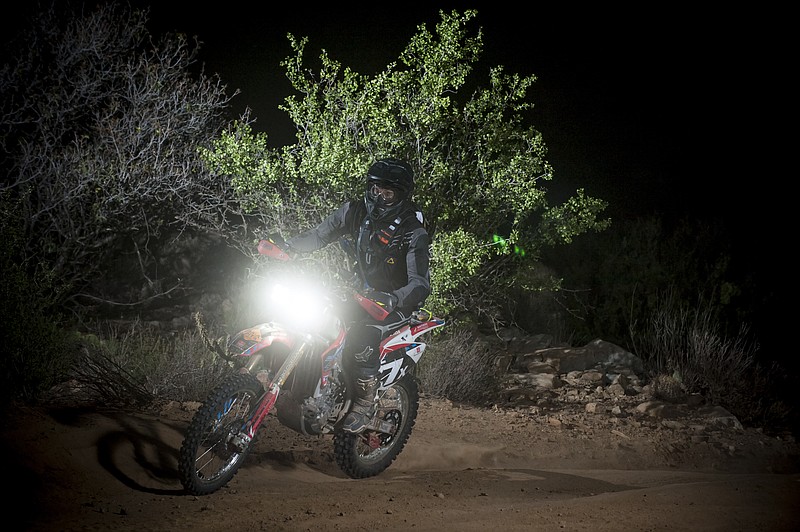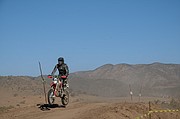Photo Gallery
Brothers in BajaThree siblings compete — and break bones — in 1,000-mile motorcycle race
Jared Wingfield was about 70 miles from the finish line of the Baja 1000 when he and his Honda CRF 450X motorcycle overshot a turn and tumbled down a small hill.
Even though he hadn't seen another competitor for miles, his first thought was to get out of the way lest one of the Super Trucks that were also in the race followed the same path and ran him over.
Sitting there in the early morning darkness last November, his next thoughts were to take inventory of the damage to his body. Thanks to adrenalin, he didn't think too much of the pain in his side, though he later discovered he had broken three ribs. He was, however, concerned about the pain in his right arm. That hurt. Luckily, it wasn't broken.
His next thoughts concerned the condition of the bike, then he thought of his brothers, Jackson and Joseph, and fellow rider Braxten Gallian and the other 16 people who made up the Wingfield Bros. Racing Team and who were waiting on him at the finish.
The sun wouldn't start coming up for another hour or so, and he was too far away from the finish line for his radio signal to reach his teammates, so he turned to getting back on the bike.
"I knew they were waiting for me," Jared, 34, says. "It wasn't just about finishing to say I finished. Not finishing would have meant letting a lot of people down."
A couple months later, sitting in a downtown Thai restaurant, Joseph and Jackson nod their heads in total agreement. Race rules require that the same bike that starts the race has to finish it.
"You worry about getting hurt, but mostly you worry about breaking the bike," Jackson says. "If you break the bike, you've ruined it for everyone."
Jared managed to get up, pointed the bike towards the finish line and kept calling out to his team on the radio.
"You're out there all alone and it can be lonely and surreal," he says. "Having the sun start coming up and hearing them finally come over the headset was the best feeling."
How Jared, Jackson and Joseph came to be on Mexico's Baja California Peninsula on Nov. 21 at the world's oldest - and most dangerous - off-road race is almost as remarkable as the fact they finished, broken bones and all.
Life on wheels
The Wingfield brothers all grew up in Chattanooga riding dirt bikes. For the most part, they were ridden on the family farm. Only Jackson, 36, has ever raced in an official motorcycle race, and he did that only once. Yet they dreamed of competing in the Baja 1000, which they say is to motocross what the Masters is to golf or the World Cup is to soccer.
"For a kid who grew up on a dirt bike, it's the dream," says Joseph, 39.
But that's all it was for decades for the Wingfields until Jared bought a CRZ 450X and casually suggested last January that the three should do the race.
Sitting with the brothers, it doesn't take long to see how close they are. Each is tall, thin, athletically built, dark-headed and quick with a smile. Jared and Joseph work for the family-owned Wingfield Scale and Jackson works for Kenco logistics company. They like listening to each other's recollections of their adventures in Baja and easily fill in details of daring when one of the others leaves something out.
At first, the idea of competing in the Baja 1000 was just talk, they admit, but eventually they all got serious about it. Still, competing in the Baja 1000 is not as simple as filling out an application and mailing it in along with the entry fee.
Drivers require a fairly large support team (some teams have as many as 100 people), plenty of money for food, gas, equipment, lodging, etc., and planning, experience, skill and luck.
"A lot of things had to fall into place," Joseph says.
The No. 1 factor was sending an email to Johnny Campbell, the winningest Baja 1000 racer of all time, having won it every year from 1997 to 2005 and again in 2007 and 2008. It was his knowledge and experience that allowed the Wingfields to take part in the race. After some communication and a test ride, Campbell not only trained them, he helped organize the team, put a race plan into place and built the bike through his JRC Honda racing team.
"We had the nicest bike in the whole race," Jackson says.
Two other key components were finding a local sponsor in Tim Kelly and Southern Honda Powersports, and having Tim Youngblood sign on as volunteer crew chief, which he did on his own dime.
"Those were both huge," Joseph says.
Kelly says he wanted to get involved because he appreciated the gumption of the guys for wanting to tackle such a trial.
"That's it," he says. "They're local and I just admired their guts for wanting to go and do this. This thing is brutal and to have a local group that wanted to go out there is admirable and we wanted to be a part of it."
In the race
The first Baja 1000 was 48 years ago and today features around 300 teams (about half of whom do not finish each year). They compete in several classes, including motorcycles, stock Volkswagens, production vehicles, buggies, trucks and customized race vehicles. Some years the race starts and ends in Ensenada, Mexico, and in others it starts in Ensenada and ends in La Paz.
Despite their lack of racing experience, the Wingfields raced in the Pro Moto Class division and, while all racers must finish within a 32-hour window, the Wingfield team did it in 24 hours and 18 minutes, finishing 10th overall.
Some people do the race entirely on their own while some race in teams with each driver doing multiples legs. Each of the Wingfields and Gallian did two legs each. Joseph's two legs were 72 and 165 miles. He did them in 2 and 4.28 hours, respectively. He broke his leg in a similar wipeout to Jared's late into his second and final segment of the race, but he also managed to gut it out and finish.
He also attained the highest speed, topping out at 102 mph. Jared managed to hit 92 mph at one point, while Jackson says he spent some of his riding time going under 10 mph, which the terrain required. The three averaged around 40 mph.
"You can't just go wide open," Jackson says.
The course and the route change from year to year, but it always takes the riders through populated and paved areas as well as over mountains, rocks and river beds and through areas where no other living thing can be seen for miles. Competitors spend a lot of time standing up on the bike in order to see better and to use their legs as additional shock absorbers.
Teams try to match drivers and their differing skills to the course. Some are better climbers - or boulderers - and some are better navigators, for example.
Part of the strategy required to complete, much less survive, is planning pits stops. For the Wingfields, the 3.2-gallon tank on the bike equated to about 50 miles of racing before it needed to be filled, but air filters and tires also needed constant replacing.
Those are relatively easy aspects of the ordeal, or at least they're the ones you can plan for. What's harder to anticipate are the cows or cacti that suddenly appear in your way, or the locals who booby-trap the course by rolling rocks into blind spots or digging holes or by changing the directional markers just for giggles.
The bowling-ball-sized rocks that appear out of nowhere are a hazard as well, as are the patches of silt, a talc-like substance that creates a blinding cloud when the vehicles hit it. It's difficult enough to maneuver through it alone, but if you are trailing another vehicle, you are essentially driving blind through it, Joseph says.
The teams received the actual race coordinates 14 days before the race started at around 6:30 a.m. on Nov. 20, and the riders had the chance to practice their individual routes during two pre-race legs. Jackson says those were helpful, but the course they actually raced was often far different than the pre-race one. Weather, ruts created by so many vehicles saboteurs who seemed to revel in watching the vehicles wreck changed things.
But not all the locals were out to create havoc, Jackson says. Most "were great."
"We took tons of stickers (bearing the team logo), which we handed out, and I signed a ton of autographs," he says.
Between the three brothers, the Wingfields have 14 sons, and they made the entire adventure a family affair. They say the entire experience was much more than a motorcycle race; it was about pushing yourself to the limits, bonding, adventure and "going big."
"It was a delightful experience," Jared says.
"It was beautiful, with lots of dangers," Jackson adds.
Staring off into the distance, a smiling Joseph finally says, "Next time we'll race with our sons. The whole family."
Contact Barry Courter at bcourter@timesfreepress.com or 423-757-6354.

